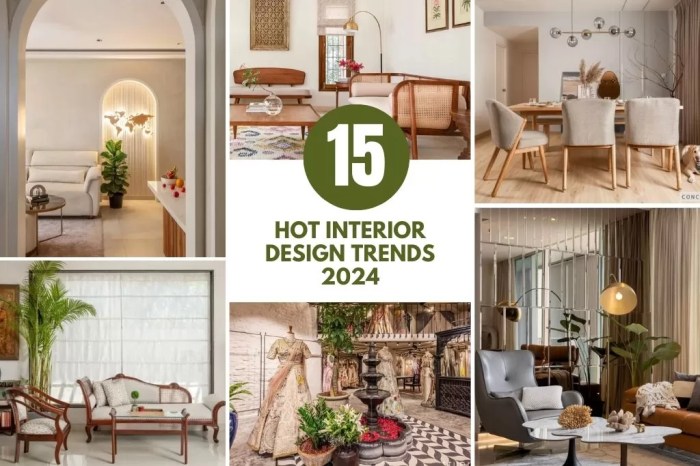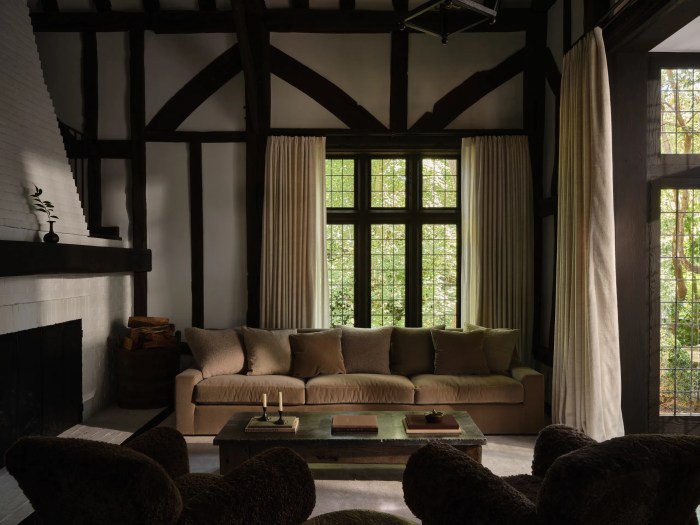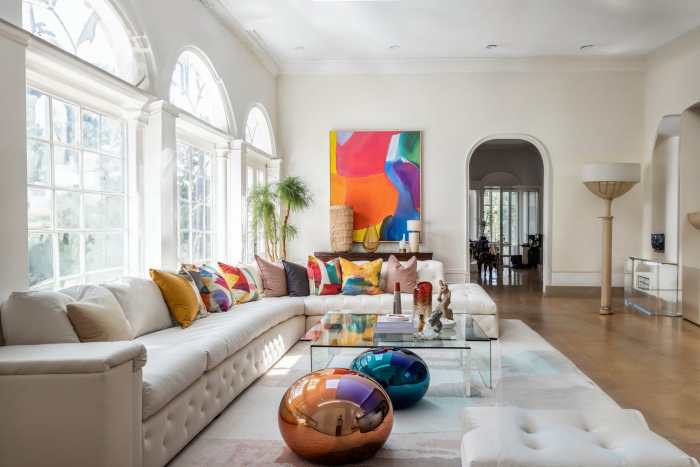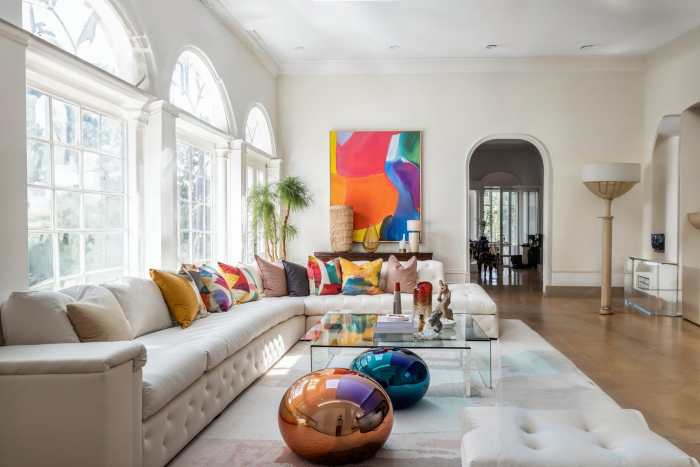2024 interior design trends house beautiful – 2024 Interior Design Trends: House Beautiful’s Guide takes us on a journey through the latest trends shaping homes, showcasing how design is evolving to embrace both functionality and aesthetics. From the resurgence of maximalism to the integration of technology, this guide explores the key elements that are transforming the way we live.
This year, we see a fascinating blend of styles and influences. Biophilic design, which emphasizes a connection to nature, is gaining momentum, while maximalism celebrates bold colors and patterns. The modern farmhouse style continues to evolve, offering a refined and contemporary twist on traditional elements.
And as technology becomes increasingly integrated into our lives, we’re seeing smart homes become more commonplace.
The Continued Embrace of Maximalism

Minimalism has had its moment, but 2024 is all about embracing the richness and vibrancy of maximalism. This design philosophy celebrates a bold and layered approach, incorporating a symphony of colors, patterns, textures, and eclectic combinations to create spaces that are both visually stimulating and deeply personal.
House Beautiful’s 2024 interior design trends are all about creating a sense of warmth and comfort. From the use of natural materials to the incorporation of biophilic design elements, the focus is on creating spaces that feel both inviting and restorative.
And while these trends can be applied to any size home, they are particularly relevant for those designing a 2 bedroom small house interior design , where maximizing space and creating a sense of flow is essential. With careful planning and the right design choices, even a smaller home can feel spacious and inviting, reflecting the latest trends in interior design.
Examples of Maximalist Design Trends in 2024
Maximalism isn’t just about throwing everything in the room; it’s about creating a cohesive and curated aesthetic. Here are some key trends that exemplify the maximalist approach in 2024:
- Bold Wallpapers:Wallpapers are no longer relegated to the past. Maximalist design embraces bold, graphic patterns and vibrant colors to make a statement. From geometric designs to floral motifs, wallpapers are a key element in creating a dynamic and personalized space.
- Statement Furniture:Maximalist design thrives on unique and eye-catching furniture pieces. Think velvet sofas with intricate carvings, vintage armchairs with bold colors, or statement lighting fixtures that become focal points in the room.
- Layered Textiles:Maximalism encourages the layering of textures and patterns. This could involve using a variety of rugs, throws, cushions, and curtains to create a sense of depth and richness.
- Eclectic Collections:Maximalism welcomes a mix of styles and eras. Don’t be afraid to combine antique pieces with modern furniture, or to incorporate elements from different cultures. The key is to create a cohesive narrative through the objects you choose.
The Influence of Global Design Trends

The world is becoming increasingly interconnected, and this interconnectedness is reflected in the world of interior design. Global design trends are influencing homes across the globe, bringing a fresh perspective and a touch of international flair to contemporary spaces.
The Rise of Global Design Influences
Global design trends are more than just a passing fad; they represent a deeper cultural exchange and a desire to connect with different aesthetics and philosophies. This trend is driven by several factors, including:
- Increased travel and exposure to diverse cultures:As people travel more and experience different cultures firsthand, they are inspired to bring elements of those cultures into their own homes.
- The rise of social media:Social media platforms like Instagram and Pinterest showcase stunning interiors from around the world, making it easier for people to discover and be inspired by global design trends.
- The growing appreciation for cultural diversity:People are increasingly interested in celebrating their own cultural heritage and learning about other cultures, leading to a greater appreciation for diverse design aesthetics.
Japanese Minimalism
Japanese minimalism is characterized by its clean lines, simple forms, and a focus on natural materials. This style emphasizes functionality and a sense of calm and serenity.
- Key elements:Natural materials like wood, bamboo, and stone are often used, while furniture is kept to a minimum, with a focus on multi-functional pieces.
- Examples:A Japanese-inspired living room might feature a tatami mat floor, low-lying furniture, and a minimalist bookshelf. A bedroom might incorporate a futon bed and simple bedside tables.
Scandinavian Hygge
Scandinavian hygge is all about creating a cozy and inviting atmosphere. This style emphasizes comfort, warmth, and a sense of well-being.
- Key elements:Warm neutral colors, natural materials like wool and wood, and soft lighting are all essential elements of Scandinavian hygge.
- Examples:A Scandinavian-inspired living room might feature a plush sofa, sheepskin throws, and a fireplace. A bedroom might incorporate a comfortable bed with soft bedding and a reading nook with a cozy armchair.
Moroccan Bohemian
Moroccan bohemian style combines the rich colors and intricate patterns of Moroccan design with the relaxed and eclectic feel of bohemian style. This style is characterized by its bold use of color, luxurious fabrics, and handcrafted details.
- Key elements:Intricate tilework, rich fabrics like silk and velvet, and vibrant colors like turquoise, gold, and crimson are all essential elements of Moroccan bohemian style.
- Examples:A Moroccan-inspired living room might feature a colorful rug, intricately carved furniture, and a lantern-lit coffee table. A bedroom might incorporate a four-poster bed with draped curtains and a vibrant patterned headboard.
The Importance of Sustainability in Interior Design
The year 2024 marks a pivotal moment for interior design, with sustainability taking center stage as a driving force shaping aesthetic choices and responsible practices. Consumers are increasingly aware of the environmental impact of their choices, and this awareness is influencing their decisions when it comes to their homes.
This shift towards eco-conscious design is not just a trend; it’s a fundamental change in how we approach creating beautiful and functional living spaces.
2024 interior design trends, as highlighted by House Beautiful, are all about creating spaces that feel both stylish and functional. This means embracing a mix of textures, incorporating natural elements, and maximizing space. For smaller homes, like a 2 bed house interior design , clever use of storage solutions and multi-functional furniture is key.
House Beautiful’s trend forecast emphasizes the importance of creating a sense of calm and serenity, making it the perfect inspiration for any home, no matter the size.
Sustainable Materials in Interior Design
Sustainable materials are gaining traction in interior design, offering a blend of environmental responsibility and aesthetic appeal. These materials are sourced ethically and have a minimal impact on the environment, making them a popular choice for homeowners who prioritize both style and sustainability.
- Bamboo: A rapidly renewable resource, bamboo is a versatile material that can be used for flooring, furniture, and even wall coverings. Its natural beauty and durability make it an attractive option for eco-conscious homeowners.
- Cork: Harvested from the bark of cork oak trees, cork is a sustainable material that is naturally fire-resistant, waterproof, and sound-absorbing. It is commonly used for flooring, wall coverings, and furniture.
- Recycled Materials: The use of recycled materials is becoming increasingly popular in interior design. These materials, such as recycled glass, plastic, and metal, are transformed into new and innovative products, reducing waste and promoting circularity.
The Art of Furniture Selection: 2024 Interior Design Trends House Beautiful
In 2024, furniture selection is not merely about aesthetics; it’s about creating spaces that are both visually appealing and functional. The right furniture pieces can transform a house into a home, reflecting your personal style while providing comfort and practicality.
This involves a thoughtful consideration of scale, proportion, and comfort, ensuring that each piece seamlessly integrates into the overall design scheme.
Furniture Trends for 2024
Furniture trends in 2024 are a blend of timeless elegance and contemporary flair, emphasizing comfort, sustainability, and personalized expression.
- Curved silhouettes:Softening sharp edges and promoting a sense of fluidity, curved furniture pieces are gaining popularity, offering a more inviting and relaxed atmosphere. Think rounded sofas, armchairs with gentle curves, and tables with organic shapes.
- Multifunctional furniture:As living spaces become increasingly versatile, furniture that serves multiple purposes is in high demand. This includes sofa beds, ottomans with storage, and desks that transform into dining tables, maximizing space and practicality.
- Sustainable materials:The demand for eco-conscious design is on the rise. Furniture made from recycled materials, reclaimed wood, and sustainable fabrics is gaining popularity, reflecting a growing awareness of environmental responsibility.
- Bold colors and patterns:2024 sees a departure from minimalist palettes. Bold colors and vibrant patterns are making a statement, adding personality and vibrancy to interiors. This trend encourages the use of statement pieces in contrasting colors and textures, creating a visually stimulating and dynamic space.
House Beautiful’s 2024 interior design trends highlight a move towards personalized spaces, incorporating elements of biophilic design and a focus on sustainability. For those looking to apply these trends to a smaller space, a 2 bhk house interior design offers a unique opportunity to experiment with bold color palettes and clever storage solutions.
Ultimately, the goal is to create a home that feels both stylish and functional, reflecting the homeowner’s individual personality and embracing the latest trends in a way that feels both current and timeless.
Creating a Cohesive Furniture Arrangement
A well-balanced furniture arrangement is essential for creating a harmonious and inviting space.
- Scale and proportion:Consider the size and proportions of furniture pieces in relation to the room. Oversized furniture can overwhelm a small space, while undersized pieces can get lost in a large room. Aim for a balance that creates a sense of visual harmony.
- Traffic flow:Ensure there is adequate space for movement and circulation around furniture pieces. Avoid placing furniture in a way that creates bottlenecks or hinders access to different areas of the room.
- Focal point:Identify a focal point in each room and arrange furniture around it. This could be a fireplace, a large window, or a statement piece of furniture.
- Balance and symmetry:Achieve visual balance by arranging furniture symmetrically or asymmetrically. Symmetry creates a sense of order and formality, while asymmetry can add visual interest and dynamism.
- Layering:Create depth and visual interest by layering furniture pieces at different heights. For example, place a coffee table in front of a sofa, or a small side table next to a chair.
The Importance of Creating a Sense of Flow

In interior design, creating a sense of flow is crucial for achieving a harmonious and welcoming space. This involves ensuring smooth transitions between different areas of the home, allowing for a natural and effortless movement throughout. A well-designed flow not only enhances the functionality of a space but also promotes a sense of calm and well-being for those who inhabit it.
The Benefits of Creating a Sense of Flow
A well-designed flow in a home can positively impact its inhabitants’ overall well-being. By promoting a sense of calm and tranquility, it can contribute to a more relaxed and enjoyable living experience. It can also enhance the functionality of a space, making it easier to navigate and utilize effectively.
Creating a Seamless Flow through Color
Color plays a significant role in creating a sense of flow. Utilizing a cohesive color palette throughout the home can create a sense of unity and visual harmony.
- Using a consistent color scheme across different rooms can help to create a seamless flow, even if the rooms have different functions. For example, using the same base color for walls throughout the house and introducing accent colors in different rooms can create a sense of unity while allowing for individual room character.
- Using a lighter color palette in smaller rooms can help to make them feel more spacious and airy. Conversely, using darker colors in larger rooms can help to create a sense of intimacy and warmth.
- Consider using a color gradient to create a sense of flow from one area to another. For example, you could use a lighter shade of blue in the living room, transitioning to a darker shade of blue in the dining room.
This creates a subtle but effective visual connection between the two spaces.
Creating a Seamless Flow through Lighting, 2024 interior design trends house beautiful
Lighting is another critical element in creating a sense of flow. It can be used to highlight certain areas of the home, create visual interest, and define different zones.
- Use a combination of natural and artificial lighting to create a well-lit and inviting space. Natural light is ideal for creating a bright and airy atmosphere, while artificial lighting can be used to create ambiance and highlight specific features.
- Consider using dimmers to adjust the lighting levels in different areas of the home. This allows you to create different moods and atmospheres, depending on the time of day and the activity taking place.
- Using track lighting can be an effective way to create a sense of flow in a long hallway or corridor. By strategically placing track lights, you can highlight artwork, architectural features, or create a sense of movement through the space.
Creating a Seamless Flow through Furniture Placement
Furniture placement is essential for creating a sense of flow. Furniture should be arranged in a way that allows for easy movement throughout the space and promotes a sense of balance and harmony.
- Avoid placing furniture in a way that blocks traffic flow. This can create a sense of claustrophobia and make the space feel smaller.
- Use furniture to define different areas of the home. For example, you could use a sofa to separate the living room from the dining room, or a rug to define the seating area in a larger room.
- Consider using furniture with curved edges to create a more fluid and welcoming feel. Sharp edges can create a sense of tension and disrupt the flow of the space.
Creating a Seamless Flow through Architectural Features
Architectural features can also play a role in creating a sense of flow. This includes elements like doorways, arches, and staircases.
- Using doorways with wide openings can create a sense of openness and flow between rooms. Conversely, using doorways with narrower openings can create a more intimate and defined space.
- Arches can be used to create a sense of grandeur and flow, especially in hallways or between rooms. They can also help to define different areas of the home.
- Staircases can be used to create a sense of movement and flow. They can also be used as a focal point in the home. For example, a grand staircase with ornate railings can be a beautiful and dramatic feature in a home.
Final Review
The 2024 interior design landscape is dynamic and exciting, offering a wealth of inspiration for homeowners seeking to create spaces that are both beautiful and functional. By embracing the trends highlighted in this guide, you can transform your home into a haven that reflects your unique personality and style, while also embracing the principles of sustainability and well-being.
Whether you’re drawn to the warmth of biophilic design, the vibrancy of maximalism, or the timeless elegance of modern farmhouse, there’s a trend waiting to be discovered and implemented in your own home.
FAQ Guide
What are some of the most popular color palettes for 2024?
Earthy tones like terracotta, sage green, and deep blues are popular, as are warm neutrals and vibrant accents.
How can I incorporate biophilic design into my home?
Start by adding plants, using natural materials like wood and stone, and maximizing natural light. Even incorporating elements like water features or artwork depicting nature can create a sense of connection to the outdoors.
What are some examples of smart home technologies that are becoming increasingly popular?
Voice assistants like Alexa and Google Home, automated lighting systems, smart thermostats, and security systems are all becoming more commonplace.




